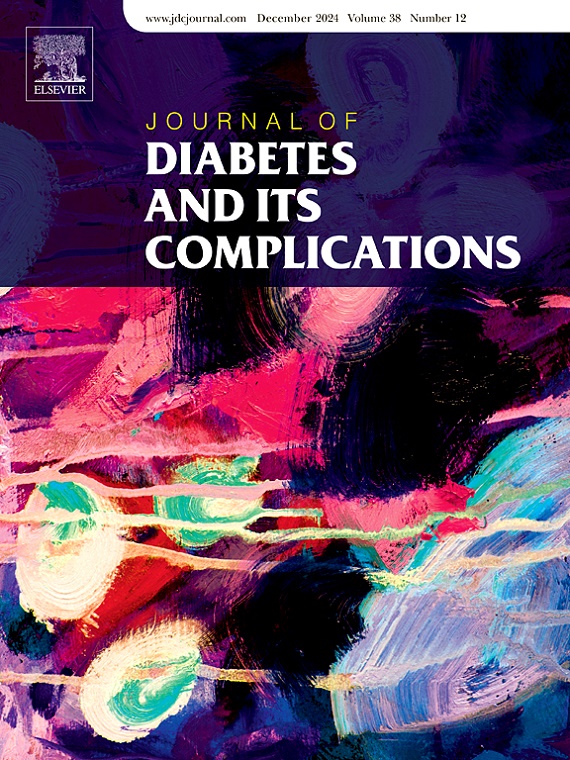Modulation of the sodium-chloride cotransporter by insulin in auditory cells: A potential link to diabetes-related hearing complications
IF 3.1
3区 医学
Q3 ENDOCRINOLOGY & METABOLISM
引用次数: 0
Abstract
Aim
While diabetes mellitus (types 1 and 2) is known to negatively impact vestibular and auditory function, the precise mechanisms underlying this effect are not fully understood. Building on our previous findings, which demonstrated the presence of insulin signaling components within the human saccule and identified the sodium transporter ENaC as a target for insulin signaling in HEI-OC1 auditory cells, this study aimed to investigate the role of the sodium-chloride cotransporter (NCC) in insulin signaling and to identify the upstream signaling pathways involved.
Methods
We utilized a combination of kinase inhibitors, ceramide treatments, and western blot analysis to evaluate the effects of insulin and induced insulin resistance on NCC phosphorylation and the related upstream signaling pathways in HEI-OC1 cells.
Results
Insulin treatment resulted in a dose-dependent increase in NCC phosphorylation. This phosphorylation was significantly attenuated by the phosphatidylinositol 3-kinase (PI3K) inhibitor wortmannin, the protein kinase B (PKB) inhibitor MK2206, the protein kinase A (PKA) inhibitor H89, and ceramide. Conversely, the serum/glucocorticoid regulated kinase 1 (SGK1) inhibitor GSK650394 did not affect insulin-induced NCC phosphorylation, although it did block insulin-induced phosphorylation of the SGK1 substrate, NDRG1. Furthermore, WNK1 (With-No-Lysine Kinase 1), a proposed downstream target of PKB and a regulator of NCC, also exhibited insulin-induced phosphorylation, dependent on PI3K, PKB, PKA, and ceramide.
Conclusions
These findings indicate that insulin promotes NCC phosphorylation, likely through the PI3K/PKB/WNK1 signaling pathway, with a possible contribution from cAMP/PKA signaling. This suggests that insulin-mediated NCC phosphorylation may influence inner ear sodium homeostasis. This mechanism could potentially contribute to the inner ear dysfunction observed in diabetes.
胰岛素对听觉细胞中氯化钠共转运体的调节:与糖尿病相关听力并发症的潜在联系
虽然已知糖尿病(1型和2型)会对前庭和听觉功能产生负面影响,但这种影响的确切机制尚不完全清楚。在我们之前的研究结果的基础上,我们发现人囊内存在胰岛素信号传导成分,并确定了钠转运体ENaC是HEI-OC1听觉细胞中胰岛素信号传导的靶点,本研究旨在研究氯化钠共转运体(NCC)在胰岛素信号传导中的作用,并确定所涉及的上游信号通路。方法采用激酶抑制剂、神经酰胺处理和western blot分析,研究胰岛素和诱导胰岛素抵抗对HEI-OC1细胞NCC磷酸化及相关上游信号通路的影响。结果胰岛素治疗导致NCC磷酸化呈剂量依赖性增加。磷脂酰肌醇3-激酶(PI3K)抑制剂wortmannin、蛋白激酶B (PKB)抑制剂MK2206、蛋白激酶A (PKA)抑制剂H89和神经酰胺显著减弱了这种磷酸化作用。相反,血清/糖皮质激素调节的激酶1 (SGK1)抑制剂GSK650394不影响胰岛素诱导的NCC磷酸化,尽管它确实阻断了胰岛素诱导的SGK1底物NDRG1的磷酸化。此外,作为PKB的下游靶点和NCC的调节因子,WNK1 (withno - lysine Kinase 1)也表现出胰岛素诱导的磷酸化,依赖于PI3K、PKB、PKA和神经酰胺。这些发现表明胰岛素可能通过PI3K/PKB/WNK1信号通路促进NCC磷酸化,cAMP/PKA信号通路可能起作用。这表明胰岛素介导的NCC磷酸化可能影响内耳钠稳态。这一机制可能导致糖尿病患者出现内耳功能障碍。
本文章由计算机程序翻译,如有差异,请以英文原文为准。
求助全文
约1分钟内获得全文
求助全文
来源期刊

Journal of diabetes and its complications
医学-内分泌学与代谢
CiteScore
5.90
自引率
3.30%
发文量
153
审稿时长
16 days
期刊介绍:
Journal of Diabetes and Its Complications (JDC) is a journal for health care practitioners and researchers, that publishes original research about the pathogenesis, diagnosis and management of diabetes mellitus and its complications. JDC also publishes articles on physiological and molecular aspects of glucose homeostasis.
The primary purpose of JDC is to act as a source of information usable by diabetes practitioners and researchers to increase their knowledge about mechanisms of diabetes and complications development, and promote better management of people with diabetes who are at risk for those complications.
Manuscripts submitted to JDC can report any aspect of basic, translational or clinical research as well as epidemiology. Topics can range broadly from early prediabetes to late-stage complicated diabetes. Topics relevant to basic/translational reports include pancreatic islet dysfunction and insulin resistance, altered adipose tissue function in diabetes, altered neuronal control of glucose homeostasis and mechanisms of drug action. Topics relevant to diabetic complications include diabetic retinopathy, neuropathy and nephropathy; peripheral vascular disease and coronary heart disease; gastrointestinal disorders, renal failure and impotence; and hypertension and hyperlipidemia.
 求助内容:
求助内容: 应助结果提醒方式:
应助结果提醒方式:


